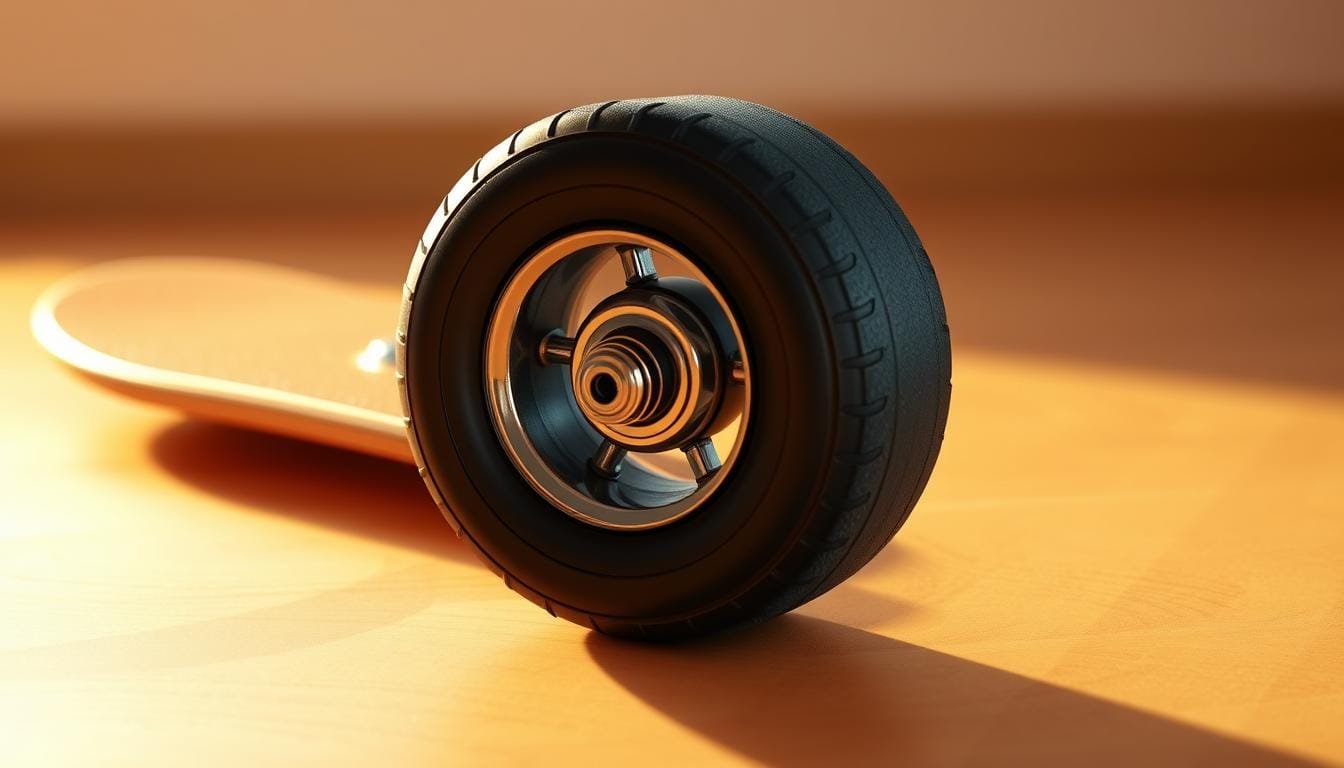Finding the right wheel size is key to a smooth cruiser skateboard ride. This guide will help you pick the best cruiser wheels. We’ll look at their size, hardness, and shape to match your style and needs.
Cruiser skateboard wheels are generally 58mm to 65mm wide. These sizes balance speed, control, and riding comfort on different surfaces. Remember, find a size that meets your preferences and where you skate. For more, see this skateboard wheel guide.
The durometer, or wheel hardness, impacts your ride’s feel on the ground. For cruiser wheels, a 76A to 80A durometer is ideal. It gives a good grip and smooth ride on rough streets.
Considering these aspects of cruiser wheels enhances your skateboarding. Both new and seasoned riders benefit from the right wheel choice. It truly changes your boarding experience.
Key Takeaways
- Ideal cruiser skateboard wheel size ranges from 58mm to 65mm in diameter.
- Durometer for cruiser wheels should typically be around 76A to 80A.
- Larger, softer wheels provide better control and comfort.
- Wheel shape and contact patch affect performance and the ride experience.
- Personal preference and intended use are crucial in selecting the best cruiser wheels.
Understanding Cruiser Skateboards and Their Wheels
Cruiser skateboards are made for easy and fun rides, perfect for getting around or casual skating. Knowing the cruiser skateboard components is key to picking the right setup.
The wheels are vital for how the skateboard works. Cruiser skateboard wheels are usually 55mm to 70mm big. This size helps with smooth rides, going over bumpy paths easily, and faster speeds. These wheels are soft, between 77a and 85a, giving better grip and a softer ride.
When picking skateboard wheel types, look at the contact patch size, which depends on the wheel design. Rounded wheels touch the ground less, for less resistance when rolling. Square wheels touch more area for better stability. These shapes affect how easy it is to roll and keep stable.
The truck type also matters. Traditional kingpin trucks (TKPs) are often found on cruisers. They sit lower than reverse kingpin trucks (RKPs), giving a lower center of gravity. This makes the skateboard easier to control and stable at slower speeds.
Cruisers also have unique kicktails and noses, different from street skateboards. This design changes how they do tricks. While cruisers can do some tricks like ollies, they’re not as good for tricks as street boards are. The skateboard wheel types and styles are key for what you want to do with your board.
Knowing about cruiser skateboard wheels, like their size, durometer, and design, helps you choose better for your skate needs.
Different Wheel Sizes and Their Uses
Choosing the right wheel size for your skateboard really matters. Wheel size impact plays a big part in how you skate. Let’s look at the different skateboard wheel diameters and what they’re used for.
If you’re into street skating, go for wheels from 50mm to 53mm. They’re quick, which helps with technical tricks and navigating streets. For a good mix of speed and control, pick wheels between 52mm and 54mm. They work well for gliding over city obstacles.
At skate parks, wheels from 55mm to 58mm are the way to go. They provide the right speed and control for ramps and bowls. For cruising, especially on rough surfaces, choose wheels bigger than 59mm. They offer a much smoother ride and are great for getting around.
Here’s a detailed comparison of different skateboard wheel diameters and their uses:
| Wheel Diameter (mm) | Best Uses |
|---|---|
| 50-53mm | Technical street skating, smaller riders |
| 54-59mm | Beginners, larger riders, all-around skating |
| 60mm and above | Specialty riding, rough surfaces, speed, cruiser boards |
Getting the wheel size impact right is key for your skateboard setup. The diameter of your wheels changes your speed, stability, and control. Always pick based on your skate style and what feels best for you.
Factors to Consider When Choosing Wheel Size
Choosing the right wheel size is key for good skateboarding. Think about how you skate and where you’ll go. Do you take to the streets, cruise, or love going fast? This choice affects your skateboarding.
Small wheels, 50-53 mm, are great for doing tricks and lighter riders. They’re quick and easy to move, making tricks easier. Medium wheels, 54-59 mm, are good for beginners and bigger riders. They offer a stable and smooth ride.
If you’re into rough terrains or fast speeds, go for wheels bigger than 60 mm. They smooth out bumpy rides and keep speed well. Using riser pads with these wheels can stop wheel bite, making your ride smooth.
The wheel’s hardness, or durometer, matters too for comfort and performance. The Durometer A Scale shows this from 78a to 101a+. Softer wheels, 78a-87a, are grippy and good on rough ground. Medium hardness wheels, 88a-95a, are great for streets. Hard wheels, 96a-101a, are best for smooth areas and fast skating.
Wheel shape affects your ride as well. Wide wheels give more stability and grip, great for transport or bowls. Narrow wheels offer less resistance. They make sliding and tricks easier for street skaters.
Picking the right wheel size will make your skateboarding better. Always think about where you’ll skate, how you skate, and the wheel’s durometer. This ensures your board is just right for you.
Recommended Wheel Sizes for Various Riding Styles
Choosing the right wheels for skateboarding is key and depends on how you ride. Each style of skateboarding needs different wheel sizes and hardness for the best performance and safety. Below is a detailed skateboarding styles wheel guide to help you pick the perfect wheels for your style:
- Street Skating: For street skating, go for smaller wheels from 50 mm to 53 mm. They are light and respond quickly, perfect for tricks and sharp moves. They should be hard, with a rating of 95A to 101A, for smooth surfaces.
- Park/Street Wheels: These wheels are usually 50-54 mm in size, with a hardness of 95-101A. They are good for both street and park skating because they offer both grip and speed.
- Cruising: Cruiser wheels are bigger, from 54 mm to 60 mm, and softer, rated between 78A and 90A. This makes for a smooth ride and good shock absorption on rough paths or for casual cruising.
- Vert Skating: Go for larger wheels up to 59 mm for vert skating. They give you the speed and stability for ramps and bowls. A durometer of 93A-100A gives the right amount of grip and smoothness.
- Longboarding: Longboard wheels are between 60 mm and 75 mm and softer, with a rating of 75A to 85A. They’re built for high speeds and bumpy roads, providing great grip and stability.
- Mini-ramps and Small Ramps: For mini-ramps, mid-sized wheels from 53 mm to 56 mm are best. They offer a nice balance of speed and agility.
By using the skateboarding styles wheel guide to find the right size and hardness, you can greatly improve your skateboarding. Choosing the best wheels for your style leads to better performance and a smoother, safer ride.
Materials and Hardness: Beyond Size
Metal and ceramic wheels are old news because of polyurethane wheels. Invented in the early ’70s by Frank Nasworthy, they last longer and perform better. The type of material used also changes skateboard wheel hardness, making rides better.
It’s important to know about the Durometer A Scale. This scale shows wheel hardness, from 78A to 103A. Wheels that are softer (78A-87A) work best on rough grounds, giving a smooth, sticky feel. But, harder wheels (96A-101A+) are better for skate parks because they’re faster, though they grip less.
You need to pick skateboard wheel hardness based on how and where you skate. For example, wheels with medium hardness (92A-95A) work well on both streets and at parks. Wheels harder than 100A are great for very smooth areas, perfect for fancy tricks.
Now, let’s compare polyurethane wheels in more detail:
| Wheel Hardness (Durometer) | Ideal Use | Characteristics |
|---|---|---|
| 78A-87A | Cruising, rough terrain | High grip, smooth ride |
| 88A-95A | All-purpose | Balanced speed and grip |
| 96A-101A+ | Skate parks, technical tricks | High speed, low grip |
Wheel shape also matters for how they perform. Conical wheels have more contact area, making them stable for park skating. On the other hand, radial wheels are lighter and slide easily, good for skating on streets. Picking the right wheels, by looking at both material and hardness, means you’ll skate better.
Tips for Testing Wheel Sizes
Finding the perfect skateboard wheels is key. Wheels range from 50mm to 75mm. Each size works best for different skate styles. It’s important to try various sizes and hardness levels.
Street skaters should go for smaller wheels, 50mm to 54mm. They’re great for quick moves and tricks. They suit both young skaters and those loving skate parks. For beginners or average skaters, wheels between 54mm to 59mm are ideal. They offer a good mix of speed and control for different skating types.
Big wheels, 60mm or more, are perfect for longboards, old-school boards, or downhill skating. They reach higher speeds and tackle rough grounds well. Cruisers love the 60mm+ wheels with soft durometer for smooth rides. Downhill enthusiasts need the biggest wheels, 70mm to 75mm, for speed and overcoming obstacles.
The hardness of the wheels, or durometer, is also crucial. Most skateboard wheels are 99A, fitting most surfaces. Softer wheels, 78A to 87A, provide better grip and smooth rides on rough terrains. Medium-hard wheels, 88A to 95A, balance speed and grip. The hardest wheels, 96A to 101A+, are best for precision in street and park skating.
Consider dual-durometer wheels for better performance. They have different hardness levels inside and out. Bigger contact patches make for smoother rides. Don’t forget to rotate your wheels regularly to wear them evenly and extend their life.
Testing wheels is a process. Each change helps fine-tune your setup for the ultimate skateboarding experience.
Maintenance and Upgrades for Cruiser Wheels
To keep your cruiser wheels performing their best, proper maintenance is essential. This includes regularly inspecting and cleaning them to catch signs of wear early on. Making sure the bearings are clean and lubricated helps your wheels spin smoothly.
Don’t forget to rotate your wheels every few months. This simple step ensures even wear and tear, helping your wheels last longer.
Looking to upgrade your cruiser wheels? There are many great choices out there. Brands like Venom, Ricta, 3DM, Bones, and Bronson make top-quality wheels. They offer something for every skater. Whether you need a smoother ride or wheels for tricks, you’ve got options. For smooth rides, go for wheels with a 78A durometer. For tricks, choose wheels rated between 86A and 92A.
Choosing the right wheel size is also important to avoid wheel bite. If you have 60mm wheels, you’ll need risers for proper clearance. For wheels that are 65mm or bigger, riser pads are a must. Using the right size risers, like 1/8″ or 1/4″ for 60mm wheels and at least 1/2″ for bigger wheels, makes a big difference.
By picking the correct wheel size and keeping them in good shape, you’ll not only enjoy cruising more but also make your wheels last longer.

I’m John Peterson, a passionate skater, blogger, and lifelong enthusiast. I’ve been skating for over 9 years and have gone on to write a blog dedicated to the sport of skating and its culture. Through my blog, I strive to share my knowledge and experience of the sport with all who are interested. From beginner tips, tricks, and equipment reviews to interviews and event coverage, I cover it all. So read my blog as I explore the wonderful world of skating!

